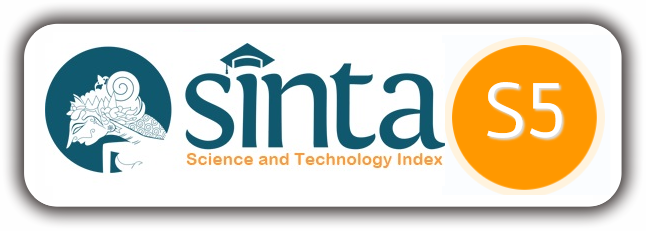Inovasi Aplikasi Online Green Waqf Berbasis Blockchain Guna Pendanaan Produktivitas Tamanu Sebagai Upaya Pelestarian Lingkungan
Abstract
Various parties are required to innovate renewable energy to support life in the future. One of the innovations to support renewable energy is utilizing the tamanu plant (Calophyllum inophyllum). Tamanu plants can reduce carbon emissions and can be processed into cosmetic ingredients and medicines that have the potential to create a sustainable business. However, the development of industry requires large costs so adequate financing is needed. One of the financing models is green waqf in the form of money by utilizing blockchain. With blockchain storage technology, data can be maintained properly. Therefore, this research aims to describe an application innovation called "Tamanoo". This research data is secondary data with a qualitative descriptive approach and literature study. The mechanism involves waqif, mauquf alaih, and government. Tamanoo is a mobile application with an integrated system connecting wakif with the tamanu industry. Through crowdfunding, waqf funds can finance the sustainable Tamanu industry, including the plantation, pharmaceutical, and biofuel industries. The steps in implementing Tamanoo include designing to evaluate prototypes, raising funds, outreach to industrial and wakif activists, and commercialization and application implementation. Through Tamanoo, it will be easier for people to make endowments and contribute directly to economic recovery and environmental improvement.
References
Bappenas, & IPB, L. (2019). Panduan Perencanaan Perkebunan Berkelanjutan Berbasis Pendekatan Yurisdiksi. Kementerian PPN/Bappenas.
Budiantoro, R. A., Wardhani, M. F., Hasanatina, F. H., & Putra, F. I. F. S. (2020). Waqf Blockchain Untuk Pengadaan Alat Kesehatan Penanganan Covid-19: Studi Konseptual. Ziswaf: Jurnal Zakat dan Wakaf, 7(2).
Emilda, E. (2019). Tumbuhan Nyamplung (Chalohyllum inophyllum Linn) dan Bioaktifitasnya. Simbiosa, 8(2),
Friday, J. B., & Okano, D. (2006). Calophyllum inophyllum (kamani) Clusiaceae (syn. Guttiferae) (mangosteen family) Species Profiles for Pacific Island Agroforestry www.traditionaltree.org. Doc-Developpement-Durable.Org, April. www.traditionaltree.org
Hasibuan, Sarwani, Sahirman, & Yudawati, N. made A. (2013). Karakteristik Fisikokimia dan Antibakteri Hasil Purifikasi Minyak Biji Nyamplung (Calophylum inophyllum L.), AGRITECH, 33(3).
Kainuma, M., Baba, S., Chan, H. T., Inoue, T., Tangah, J., & Chan, E. W. C. (2016). Medicinal plants of sandy shores: A short review on Calophyllum inophyllum and Thespesia populnea. International Journal of Pharmacognosy and Phytochemical Research, 8(12).
Kartika, I. A., Cerny, M., Vandenbossche, V., Rigal, L., Sablayrolles, C., Vialle, C., Suparno, O., Ariono, D., & Evon, P. (2018). Direct Calophyllum oil extraction and resin separation with a binary solvent of n-hexane and methanol mixture. Fuel, 221, 159–164. https://doi.org/10.1016/j.fuel.2018.02.080
Karunia, A. M. (2022). Baru 152 Perusahaan Terapkan Industri Hijau, Menperin: Kalau Tidak, Mereka Ketinggalan Kereta. Kompas.Com. https://money.kompas.com/read/2022/04/06/121000126/baru-152-perusahaan-terapkan-industri-hijau-menperin-kalau-tidak-mereka
Kementerian Perindustrian Republik Indonesia. (2021). Kemenperin Dorong Transformasi Pembangunan Industri Berkelanjutan. https://www.kemenperin.go.id/artikel/22439/Kemenperin-Dorong-Transformasi-Pembangunan-Industri-Berkelanjutan
Leksono, B., Windyarini, E., Hasnah, T. M., Saijo, Fahruni, Maimunah, S., Artati, Y., & Baral, H. (2021). Tamanu (Calophyllum inophyllum) growth performance on different types of degraded peatlands in Central Kalimantan. IOP Conference Series: Earth and Environmental Science, 914(1). https://doi.org/10.1088/1755-1315/914/1/012009
Leksono, Budi, Laksmi Hendrati, R., Windyarini, E., & Hasnah, T. (2014). Variation in Biofuel Potential of Twelve Calopyllum Inophyllum Populations in Indonesia. Indonesian Journal of Forestry Research, 1(2), 127–138. https://doi.org/10.20886/ijfr.2014.1.2.569.127-138
Mardiana, D. A., Kartoatmodjo, R. T., & Kasmungin, S. (2018). Estimation of Indonesia’s Energy Demand to 2030 and Alternatives Scenario to Reduce Oil Dependence. Indonesian Journal of Energy, 1(2).
Mayfield, M. (2011). Creating training and development programs: Using the ADDIE method. Development and Learning in Organisations, 25(3).
Nguyen, H. H., & Tran, T. T. M. (2016). Chemical composition analysis and antibacterial-antiinflammatoryactivity tests of tamanu seed oil extracted by supercritcial fluid technology. Science and Technology Development Journal, 19(3).
Putrasari, Y., Praptijanto, A., Santoso, W. B., & Lim, O. (2016). Resources, policy, and research activities of biofuel in Indonesia: A review. Energy Reports, 2, 237–245. https://doi.org/10.1016/j.egyr.2016.08.005
Ragasa, C. Y., Ebajo, V., De Los Reyes, M. M., Mandia, E. H., Brkljača, R., & Urban, S. (2015). Triterpenes from Calophyllum inophyllum linn. International Journal of Pharmacognosy and Phytochemical Research, 7(4).
Raju, D. C., & Victoria, T. D. (2015). Phytochemical screening and bioactivity studies of immature and mature leaves of Calophyllum inophyllum.L. Journal of Chemical and Pharmaceutical Sciences, 8(1).
Rejeki, S. (2015). Ekstraksi Dan Penetapan Nilai SPF Minyak Nyamplung Dengan Metode Sektrofotometri (Extraction And SPF Value Determination Of Tamanu Oil By Spectrofotometri Methode). Indonesian Journal On Medical Science, 2(1).
Sanudin. (2020). Persepsi dan Sikap Masyarakat terhadap Pengembangan Nyamplung di Desa Patutrejo, Kabupaten Purworejo (Perception and Attitude of Community towards the Development of Nyamplung Energi kerjasama antara Kementerian Energi. Jurnal Agroforestri Indonesia, 3(1).
Suryaningsih, S., Riandika, Y., Hasanah, A., & Anggraito, S. (2020). Aplikasi Wakaf Indonesia Berbasis Blockchain. Edumatic: Jurnal Pendidikan Informatika, 4(2).
Tharakan, P. (2015). Summary of Indonesia’s Energy Sector Assessment. https://www.adb.org
Veleva, V., & Ellenbecker, M. (2001). Indicators of sustainable production : framework and methodology. Journal of Cleaner Production, 9.
WaCIDS. (2022). Gerakan Green Waqf Menjadi Solusi Strategis Mewujudkan Indonesia Mandiri Energi. WaCIDS (Waqf Center for Indonesian Development and Studies). https://kumparan.com

This work is licensed under a Creative Commons Attribution-ShareAlike 4.0 International License.








